What’s the first thing that comes to mind when you think of Argentina?
For many people, it’s football or tango but for Traveleaters, it’s definitely the food. Argentinian food is fantastic, especially if you enjoy eating meat. Argentina is home to world-class beef and some of the tastiest dishes in South America.
There are plenty of reasons to visit this vast country on the southern tip of South America, but if you’re the type of traveler lured by the promise of good food, then you may want to check out these 25 traditional dishes on your next trip to Buenos Aires and Argentina.
ARGENTINIAN FOOD QUICK LINKS
If you’re planning a trip to Argentina and want to learn more about the cuisine, then you may be interested in going on a food tour.
TOURS & OTHER SERVICES
- Food Tours: Food and Wine/Drinking Tours in Argentina
- eSIM: Argentina eSIM
Save This on Pinterest!
No time to read this article on traditional Argentine foods? Click on the save button and pin it for later!
Photo by lenyvavsha
WHAT IS TRADITIONAL ARGENTINIAN FOOD?
The food in Argentina has been heavily influenced by Spanish and Italian cuisines. This can be attributed to its colonial past and history of immigration. Argentina was a colony of Spain for 300 years and it welcomed 6.6 million immigrants between 1853 and 1955, mostly from Italy and Spain. In fact, Argentina has the second largest number of immigrants in the world, behind only the US.
Dishes like empanadas and puchero are vestiges of Spanish influence while pizza, milanesa, and various pasta dishes were introduced to the Argentine diet by Italian immigrants. So deeply-rooted is the Italian influence on local food and culture that many Argentinians identify themselves as being more European than Latin American, a point of view that doesn’t always sit well with their neighbors in South America.
People familiar with traditional Argentine foods know about the country’s legendary love for meat, especially beef. Argentina is consistently one of the largest consumers of beef in the world, with the average Argentinian putting away an estimated 129 pounds every year. That sounds like an impossibly high number until you experience an asado.
The Argentinian love for steak can again be traced back to its time as a former Spanish colony. Cattle was first introduced to Argentina by Spanish settlers in 1536. Thanks to the geography of the Pampas lowlands, they multiplied rapidly and became a top food source in Argentina. Today, Argentina is one of just five countries that has more cattle than people.
If you enjoy wine, then you’ll be pleased to know that Argentina is the world’s fifth largest producer of wine. They’re especially known for their Malbec wines, which like their beef, is hardly exported and consumed mostly within the country.
THE BEST IN ARGENTINE CUISINE
This article on the best-tasting Argentine foods has been organized by category to make it easier to digest. Click on a link to jump to any section of the guide.
NATIONAL DISHES
1. Empanada
There’s no better way to start this Argentinan food guide than with the humble empanada, a fried or baked pocket of dough stuffed with a savory filling. It comes in dozens of varieties and is popular in the cuisines of many former Spanish colonies like Chile, Belize, Venezuela, Costa Rica, Peru, and the Philippines.
The name empanada stems from the Spanish word empanar, which means “to bread” or “to wrap something in bread”. It’s a derivative of the Indian samosa and first appeared in the Iberian peninsula sometime during the medieval period. The earliest recipes for empanada date back to the start of the 16th century.
How the empanada came to Argentina isn’t entirely clear, but it’s believed to have been introduced to the country by immigrants from northern Spain. The early version of Argentine empanada was a large, double-crusted pie that was cut into slices. Over time, it evolved into the single pockets of filled pastry crust that we know and love today.
These days, there are about as many versions of empanada as there are Argentinian cooks but some of the most common varieties are filled with ground beef, chicken, ham and cheese, spinach, and humita. They can be baked (Salta-style) or fried (Tucuman-style) with every region in Argentina having its own distinct style. Here are some of the most delicious empanadas you can try in Argentina.
Empanada Tucumana: Filled with either chicken, mondongo (tripe), or beef along with other ingredients like spring onions, pimento, and vinegar. Tucumán province takes such pride in their empanadas that they play host to the National Empanada Festival in September every year.
Empanada Salteña: Smaller than empanada tucumana and made without any fat or oil. Potatoes, hard-boiled eggs, green onions, red peppers, and ground chili are common fillings.
Empanada Jujeña: Filled with beef, chicken, goat, and llama meat. Peas, onions, garlic, and chili are also common ingredients.
Empanada Cordobesa: A sweeter type of empanada made with white sugar and filled with beef, raisins, potatoes, and olives.
Empanada Entrerriana: Empanada filled with milk-soaked rice.
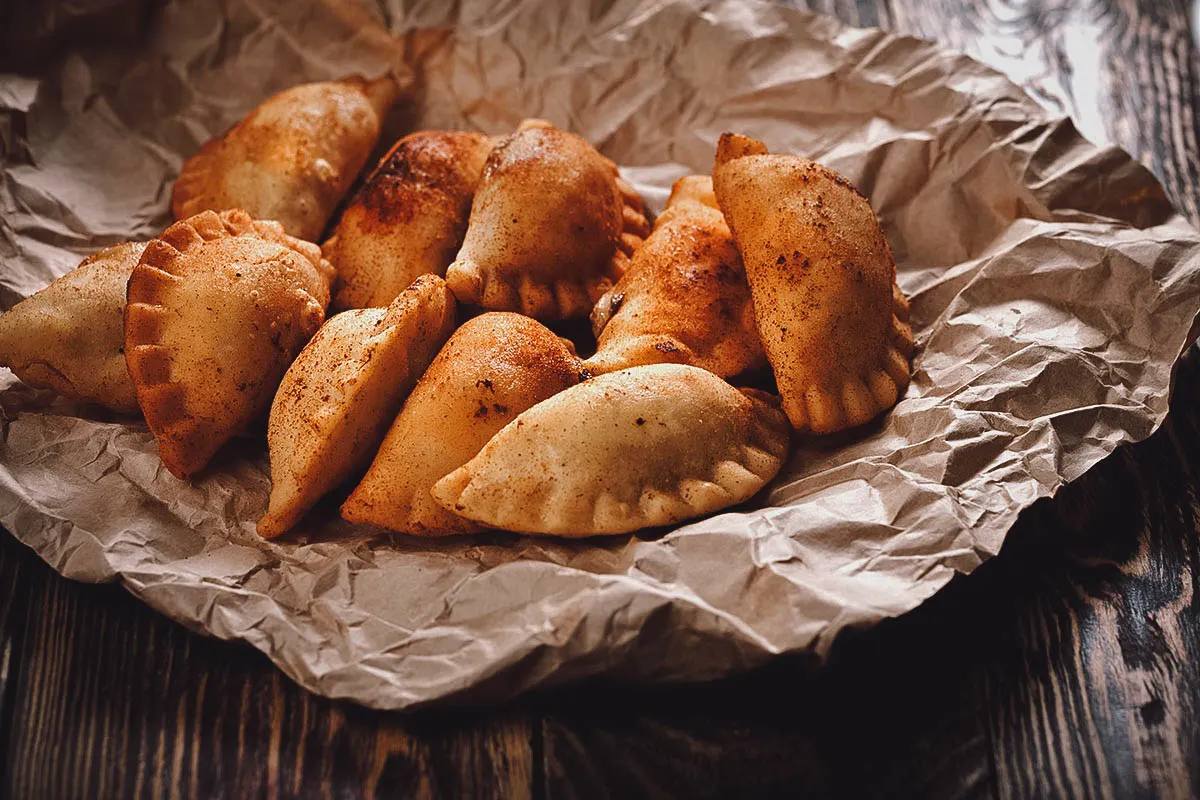
Photo by maxsol7
2. Locro
Locro refers to a traditional meat-and corn-based Argentinian stew that’s associated with the native Andean people of South America. It’s popular in Argentina and in other countries like Bolivia, Peru, Ecuador, Chile, and Paraguay.
Like empanada, there are many recipes for locro in Argentina but it’s typically made with a variety of vegetables and meat like white hominy, squash, white beans, potatoes, carrots, pork, beef, pancetta, and sausage. The ingredients are simmered in a pot for several hours until a rich, thick consistency is achieved.
In Argentina, locro is a national dish that’s near and dear to the hearts of many people. It can be consumed at any time of the year but it becomes especially significant on May 25th when it’s made to celebrate the anniversary of the May Revolution.
The May Revolution was a critical turning point in the bid for South American independence. It led to the removal of Spanish rule and the establishment of a local government – the Primera Junta – that would eventually become Argentina.
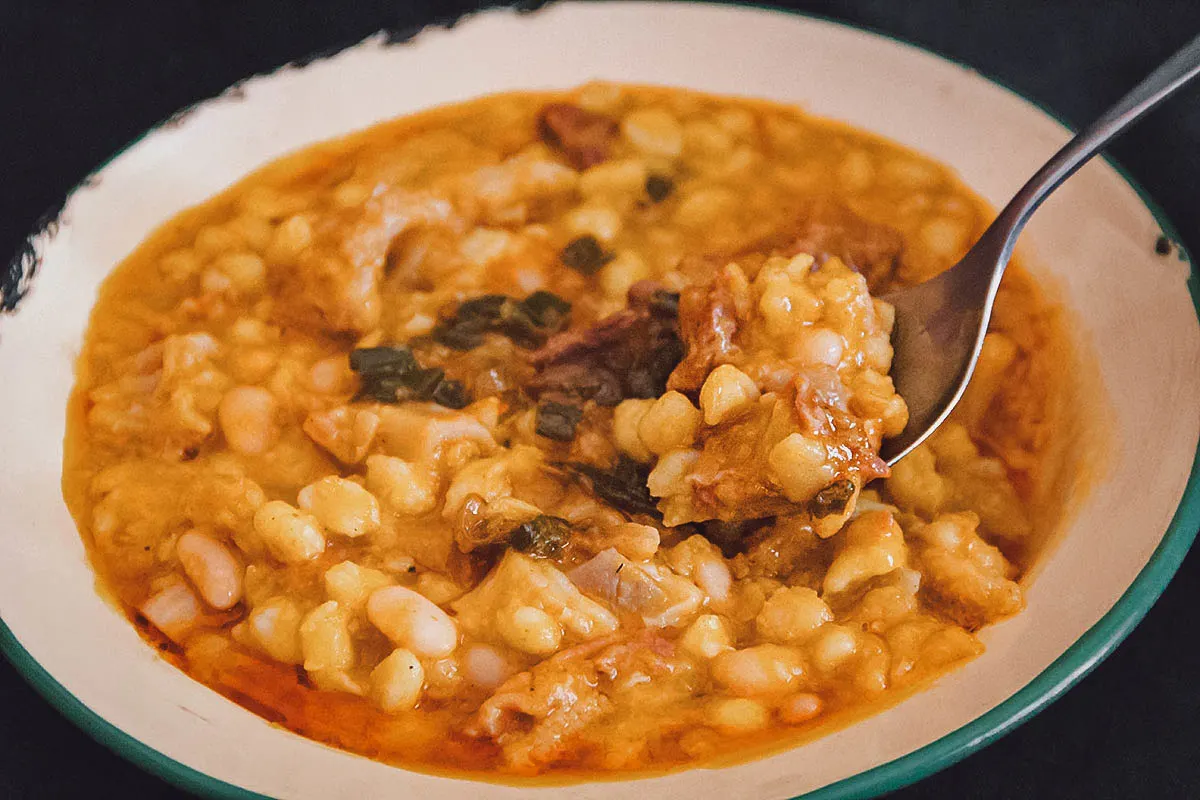
Photo by Wirestock
3. Choripán
If you’re a fan of sandwiches, then you’re probably going to enjoy choripán, Argentina’s answer to the hot dog. Popular in many countries throughout South America like Argentina, Peru, Uruguay, Chile, and El Salvador, it consists of a grilled chorizo sausage served in a crusty bread bun.
Choripán comes in many forms but in Argentina, it’s made with a beef or pork sausage sliced down the middle and served in a roll with chimichurri or salsa criolla (onion relish). It’s a popular street food dish in Argentina, especially outside football stadiums, and is typically eaten as an appetizer during the preparation of asado.
If you visit the Rio de la Plata region of Argentina, then be sure to try morcipán, a variant of choripán made with morcilla or blood sausage.
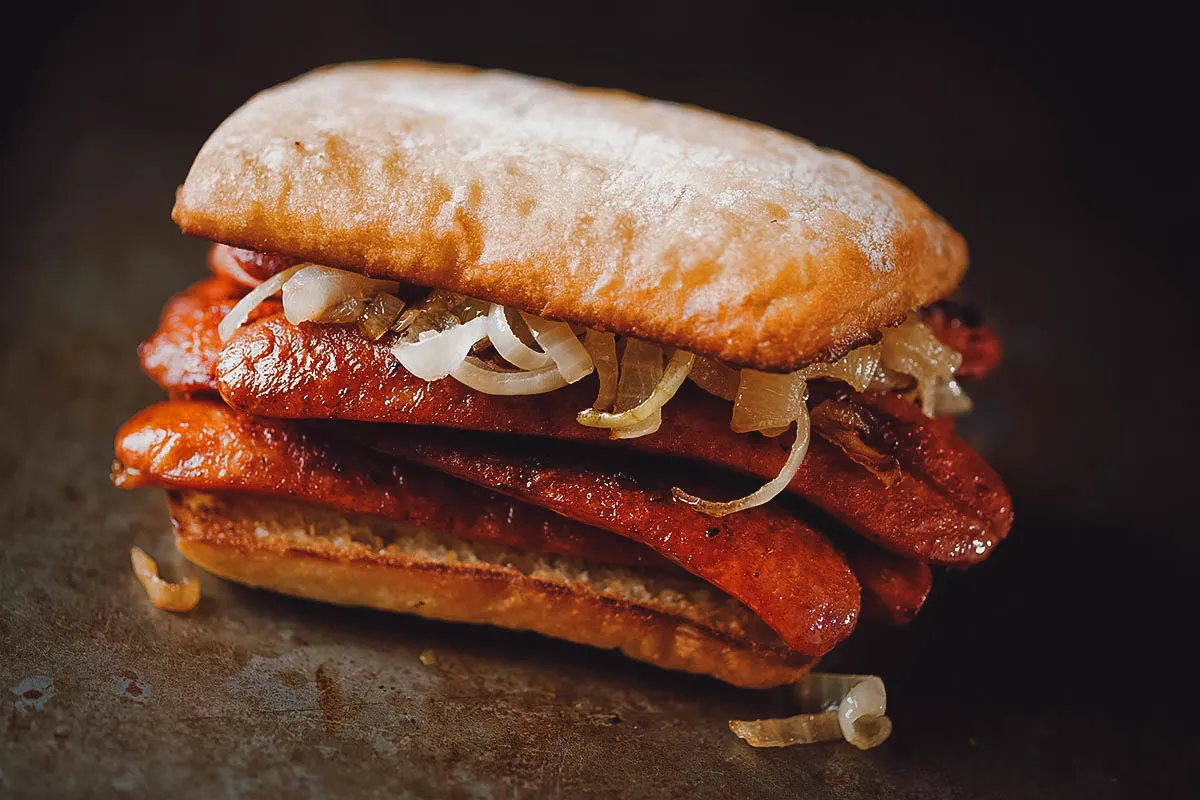
Photo by zkruger
4. Milanesa
The milanesa is one of the most delicious examples of the Italian influence on Argentine cuisine. Popular throughout the Americas, it’s the South American version of the Italian cotoletta. Its name is derived from Milan’s cotoletta alla milanese, a dish brought to South America by Italian immigrants in the late 19th and early 20th centuries.
Milanesas are made with prime slices of beef that are pounded, breaded, and fried. It’s similar to the Austrian/German wiener schnitzel, American chicken fried steak, or Japanese tonkatsu. In Argentina, it’s typically made with a lean cut of beef but it can be made with pork, veal, or chicken as well.
Milanesas in Argentina are often served with french fries or mashed potatoes. They can be served as is or topped with tomato sauce and cheese in a variation called milanesa a la napolitana (pictured below). So ingrained are milanesas in Argentinian cuisine and culture that the dish is celebrated every May 3rd during el Día de la Milanesa.
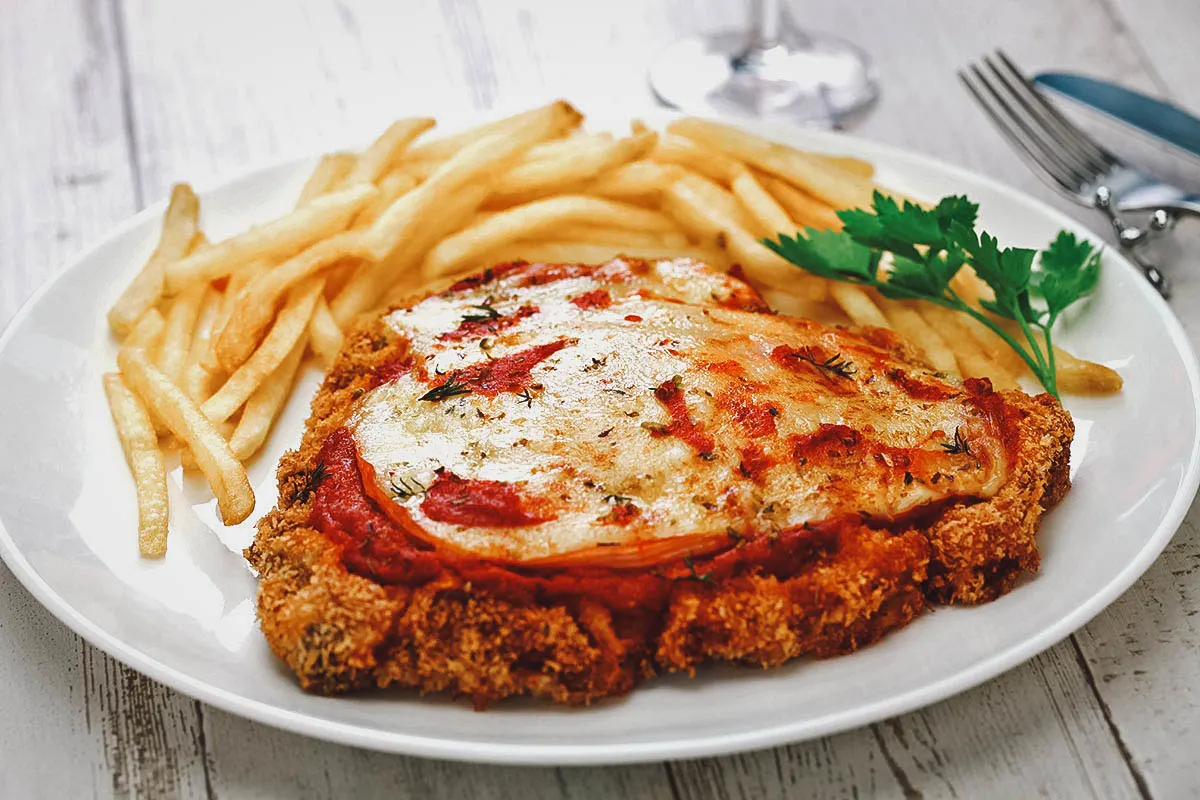
Photo by asimojet
When served with a fried egg on top, the dish is known as milanesa a caballo or “milanesa riding horseback”. This is one of the most popular versions of milanesa in Argentina.
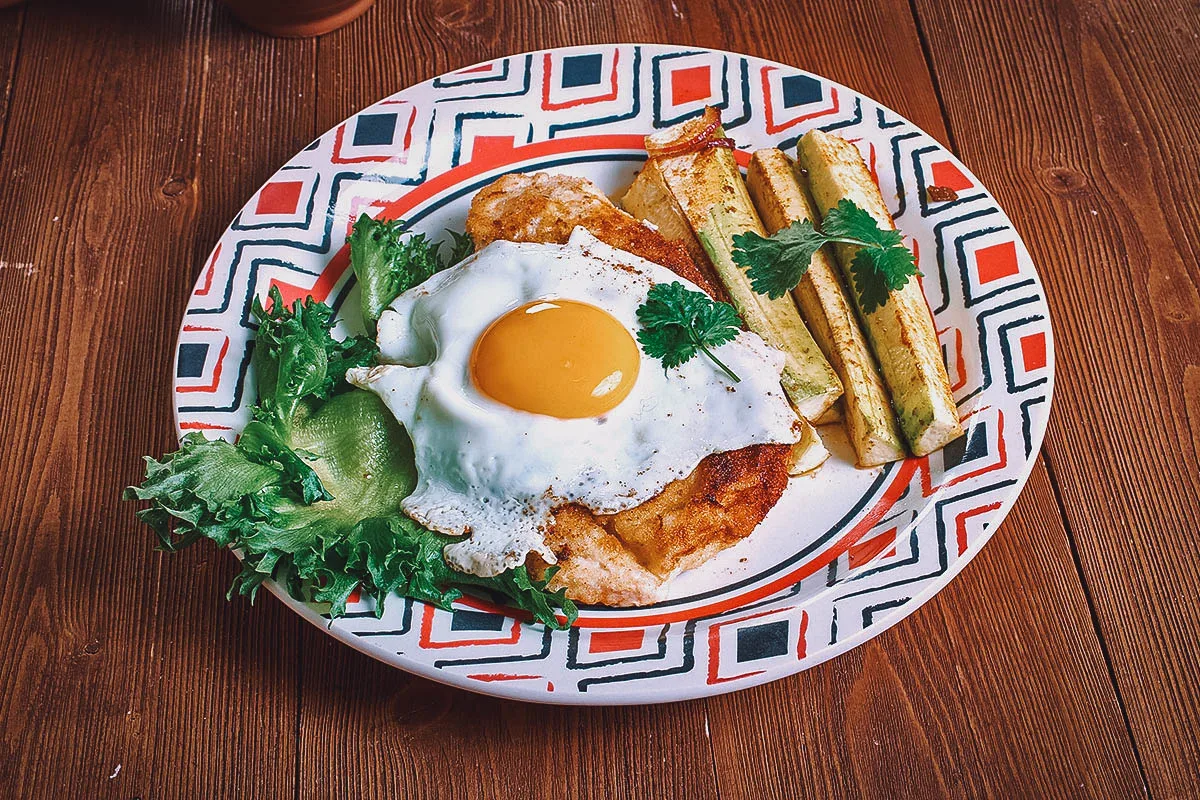
Photo by fanfon
5. Asado
Scroll through this Argentine food guide and it becomes clear that Argentinians are no strangers to delicious food. But for many locals, one gastronomic experience stands above the rest – asado. It refers to an Argentinian barbecue that’s much more than just your typical barbecue.
Asado means “roasted” in Spanish and refers to an Argentinian meal and style of cooking that features a wide array of grilled meat. Different meats like lamb, pork, and mutton are roasted though beef is preferred. The meats are cooked on a cast iron grill called a parrilla using either a charcoal (parrilla al carbón) or wood (parrilla a leña) burning fire. Smaller pieces of meat are cooked horizontally while larger cuts are roasted vertically or diagonally (pictured below).
The asado tradition in Argentina dates back to the time of the gauchos. These skilled horsemen lived entirely off the land so they survived on the wild cattle that roamed the plains of La Pampa in central Argentina. They ate so much beef that they became masters at slow-roasting meat so it stayed juicy, tender, and very flavorful.
Today, asado in Argentina means so much more than just the meal itself. Similar to South African braai, meats are roasted for hours giving friends and family the opportunity to socialize and enjoy each other’s company. Diners typically snack on smaller dishes like empanadas, provoleta with chimichurri, and choripán while waiting for the meats to cook. To Argentinians, asado is a social event and an important symbol of their culture and heritage.
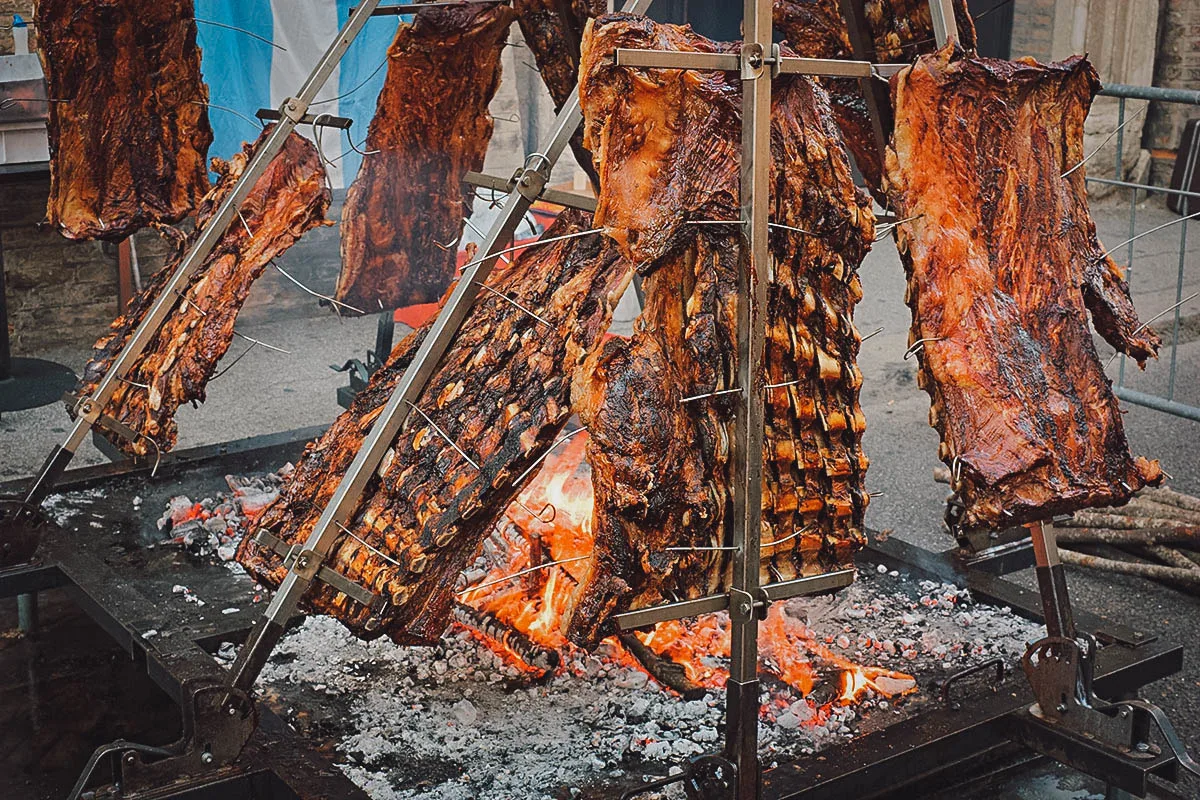
Photo by ermess
Asado is bound by tradition in Argentina so even the order in which the meat is cooked needs to be respected. Less “noble” parts of the animal like the offal are grilled first while the best parts are saved for last.
Chorizo sausages, morcillas (blood sausage), and achuras (offal) are typically grilled first at an asado along with thin cuts of meat like matambre (flank steak) and entraña (skirt steak).
These are then followed by the choicest cuts like bife de chorizo (sirloin), bife ancho (ribeye), bife de costilla (porterhouse), and lomo (tenderloin). They’re slow-cooked to perfection and eaten with chimichurri and salsa criolla along with a variety of salads and side dishes.
If you eat like a bird, then an asado probably isn’t for you. Several kilograms of meat are roasted at a typical asado with about 800 grams being apportioned to every man and 600 grams to every woman. ¡Buen provecho!
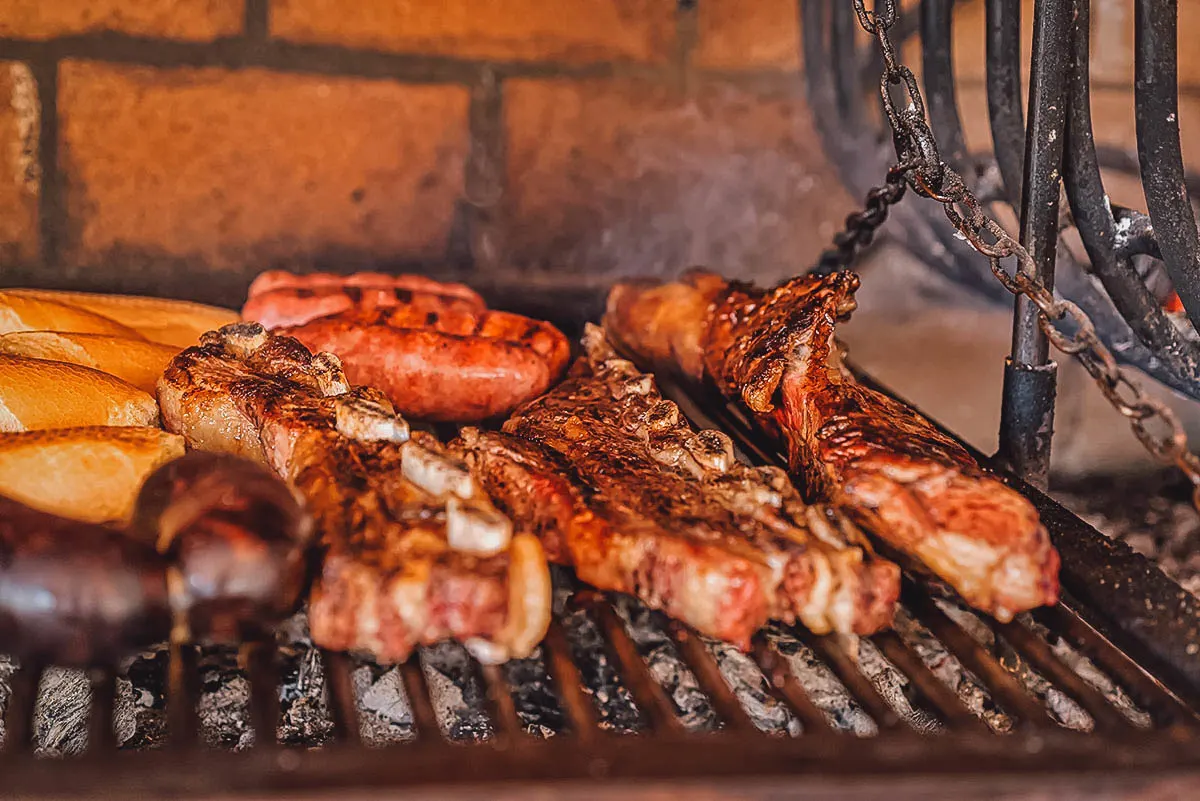
Photo by [email protected]
6. Alfajor
If you have a sweet tooth, then you’re going to love alfajores, a must-try Argentinian cookie sandwich popular throughout Latin America, Spain, and the Philippines. It’s especially popular in Uruguay, Peru, and Argentina where it’s considered a national dish.
Alfajores come in many shapes and sizes but it typically consists of two round shortbread cookies filled with dulce de leche. They’re traditionally dusted with powdered sugar but they can be glazed or covered in grated coconut or chocolate as well. Alfajores are so popular in Argentina that the country is estimated to consume over a billion of these delicious cookie sandwiches a year!
Argentina may be the world’s largest consumer of alfajores but the title for the world’s biggest alfajor goes to Uruguay. According to Guinness World Records, the record-setting cookie measured almost 2 meters in diameter (6.6 ft), 80 centimeters in height (31.5 in), and weighed in at a whopping 464 kilograms (1,023 lbs).

Photo by lenyvavsha
STARTERS / SOUPS / SIDES
7. Humita
Humitas are an ancient Andean food that pre-dates the Hispanic period. They’re consumed in many countries throughout South America like Bolivia, Ecuador, Peru, and Chile. In Argentina, they’re common in the Salta and Jujuy regions of northwest Argentina.
Recipes for humitas vary from country to country but in Argentina, they’re typically made from a dough consisting of fresh corn, sautéed onions, and spices. Depending on the region, they can be made with other ingredients as well like red peppers, pumpkin, tomatoes, milk, cheese, and spring onions. Like tamales, the dough is wrapped in corn husks and then boiled or steamed.
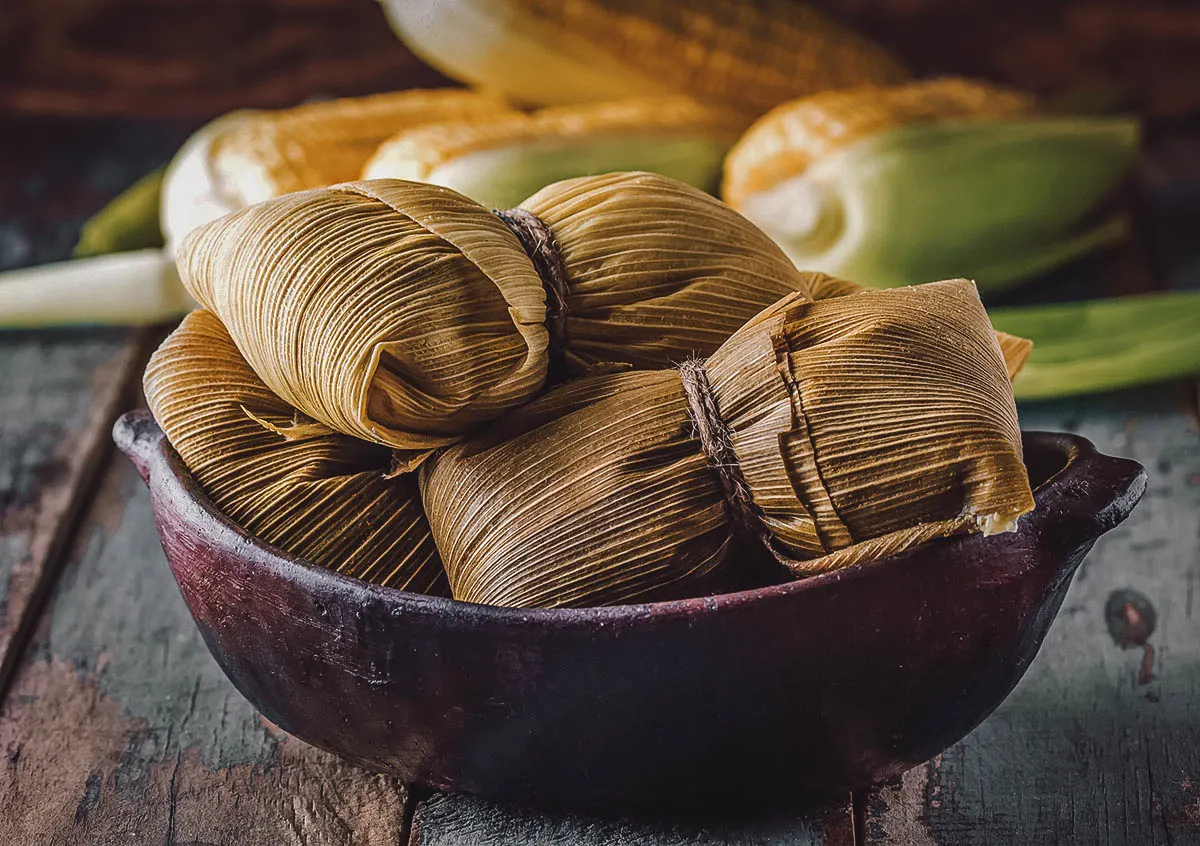
Photo by Blinovita
8. Tamales Salteños
Tamales are a traditional Mesoamerican dish that’s popular in the cuisines of many countries throughout Latin America. In Argentina, a version known as tamales salteños is popular in the northwest region of the country, mainly in Salta, Jujuy, and Tucumán.
Tamales salteños are made with fresh corn husks filled with a mixture of corn flour, minced meat, and other ingredients like squash, onions, peppers, garlic, pimentón, and hard-boiled eggs. The corn husks are tied on both ends and then cooked in boiling water.
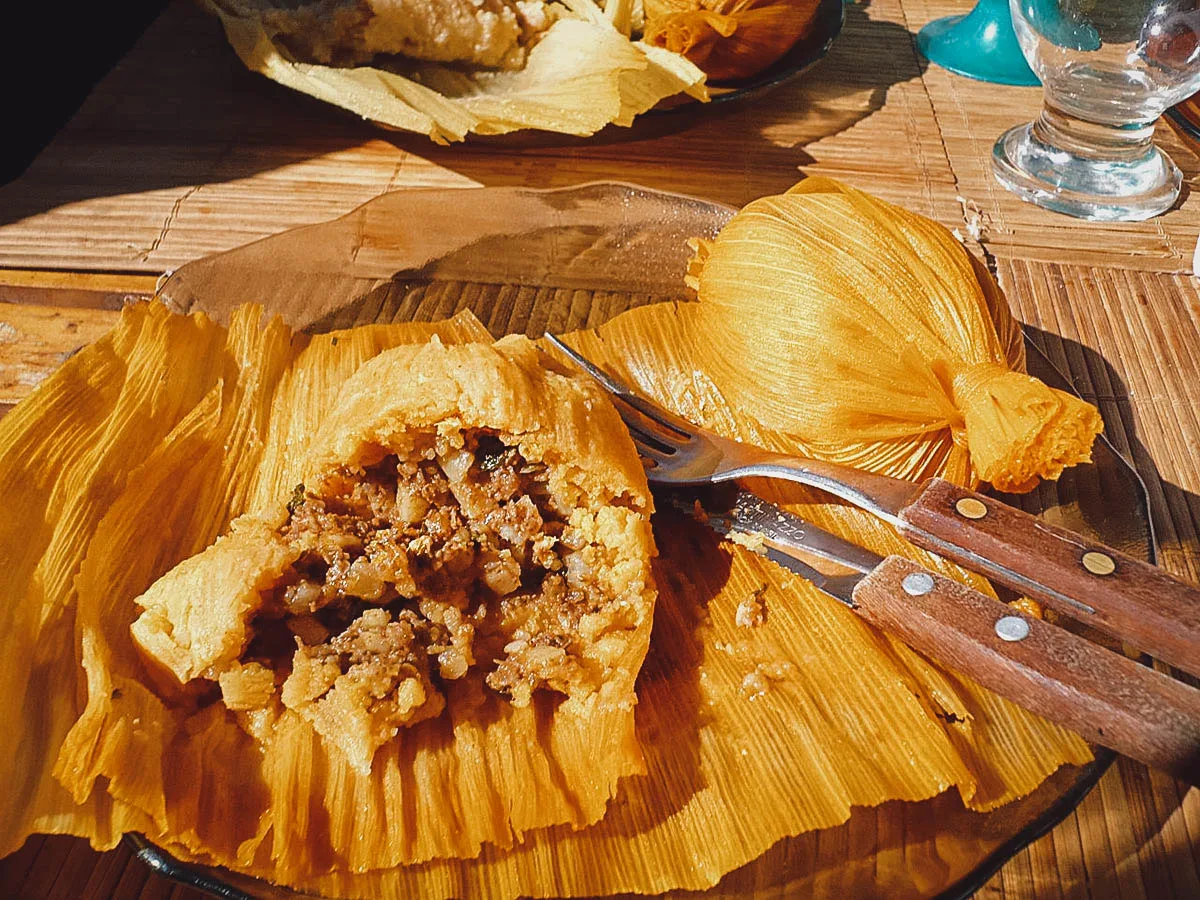
Photo by Gonzalo Rivero, CC BY-SA 3.0, via Wikimedia Commons / Processed in Photoshop and Lightroom
9. Provoleta
It’s pretty clear that Argentinians love grilled meat. As it turns out, they enjoy grilled cheese as well. Provoleta refers to the Argentinian version of provolone cheese. It’s a staple side dish at asados and is always eaten grilled, usually with crushed red chili and oregano sprinkled on top.
Provoleta was invented out of a desire to fuse Argentinian and Italian cuisines. It was invented by Don Natalio Alba, a native Calabrian who settled in Argentina and worked in the dairy industry. Because Argentina has a large population of Italian descent, he wanted to introduce a typically Italian dish into the asado, and so was born the Italian version of provolone cheese known as provoleta.
Small discs of provoleta are seasoned with chili and oregano before being placed on the grill. As it cooks, the cheese melts inside but holds its shape. When ready, the provoleta is eaten communally with chimichurri and bread at the start of an asado.
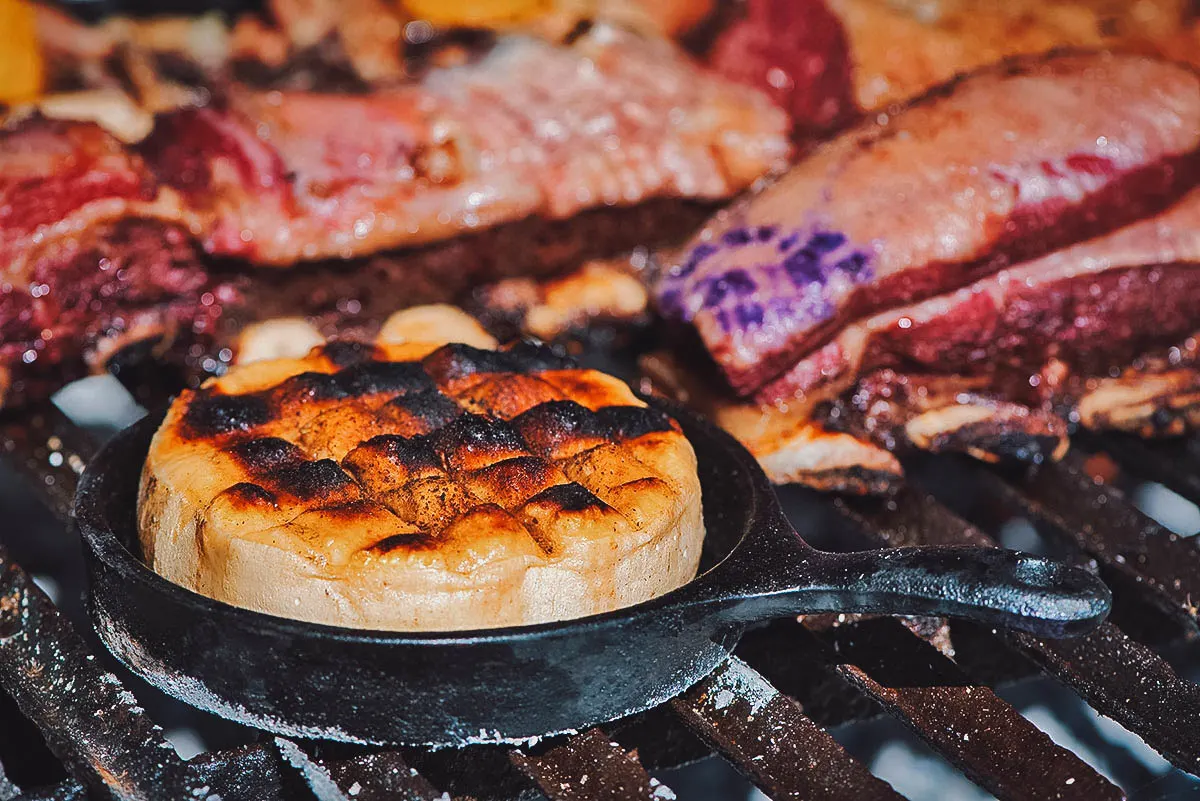
Photo by info.galofernandez.com
10. Chimichurri
When you think of Argentinian condiments, chimichurri is the first that comes to mind. It refers to an uncooked green sauce (chimichurri verde) made with finely chopped parsley, minced garlic, oregano, olive oil, and red wine vinegar. It’s typically used as a table condiment with grilled meats or as an ingredient that’s basted onto meat as it cooks.
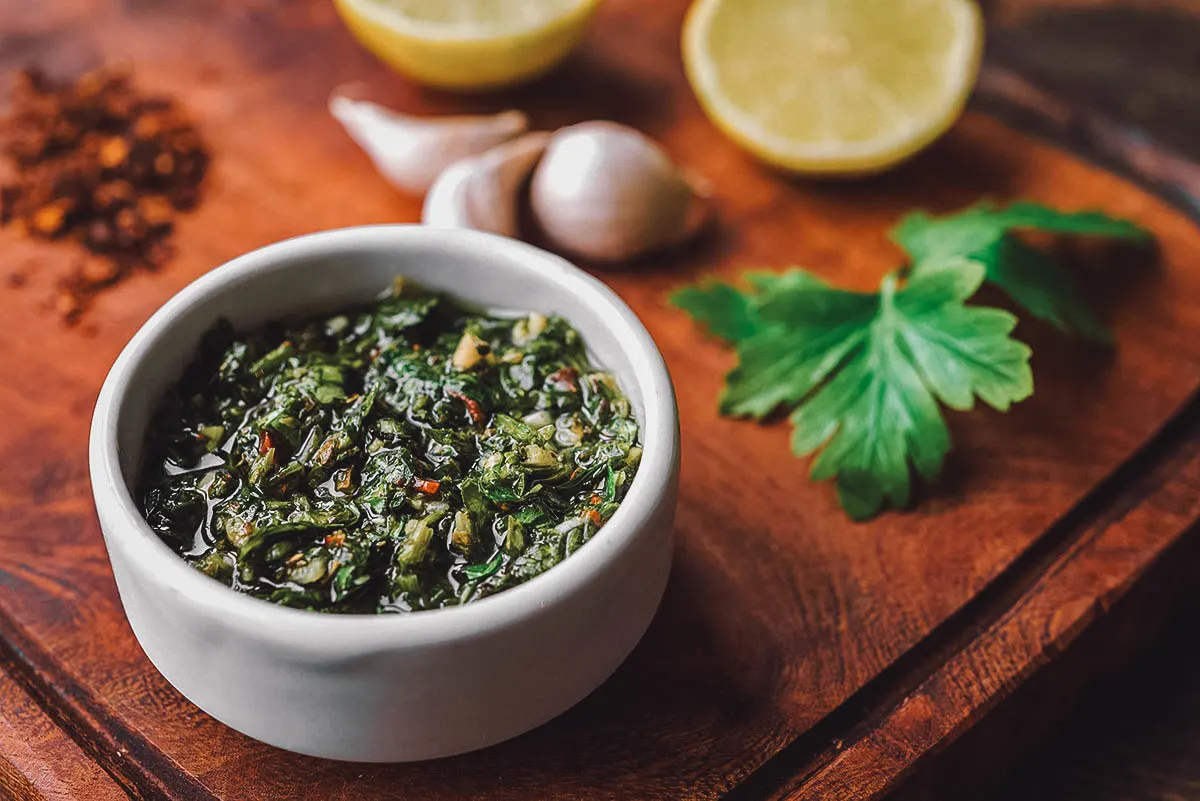
Photo by mejikyc
This classic Argentinian condiment comes in two versions – chimichurri verde (green) and chimichurri rojo (red). In addition to the standard ingredients like chopped parsley, garlic, and olive oil, chimichurri rojo is made with paprika and sometimes ripe tomatoes and red bell peppers. They impart a savory and spicy kick and give the sauce its characteristic red color.
Like chimichurri verde, chimichurri rojo is often paired with grilled meat and other Argentine dishes like seafood, roasted vegetables, and empanadas.
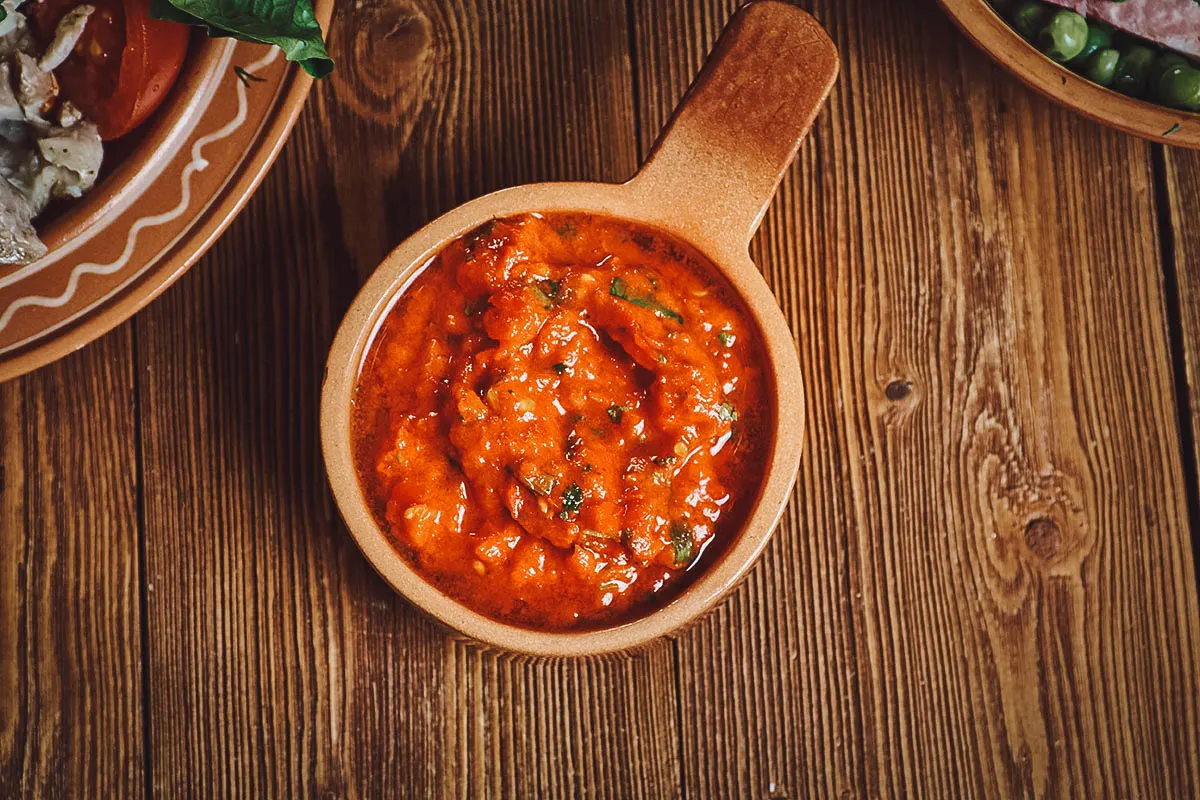
Photo by fanfon
BREADS
11. Chipa
Chipa refers to a small cheese-flavored roll popular in the cuisines of Paraguay, Bolivia, Brazil, and Argentina. A traditional bread of the indigenous Guaraní people, it’s typically eaten for breakfast or as a snack and commonly sold as street food in Argentina.
Traditionally, chipas were made with just cassava flour but the arrival of livestock with the Spanish colonists introduced other ingredients to the recipe like cheese and eggs. Today, you’ll find Argentinian chipas made with different types of cheese and fillings like ham, vegetables, or ground meat.
If you ride the bus often in Argentina, then you may find vendors selling warm chipa in large baskets. If you’re really hungry, then I suggest buying twelve, because they’re chipa by the dozen. Sorry.
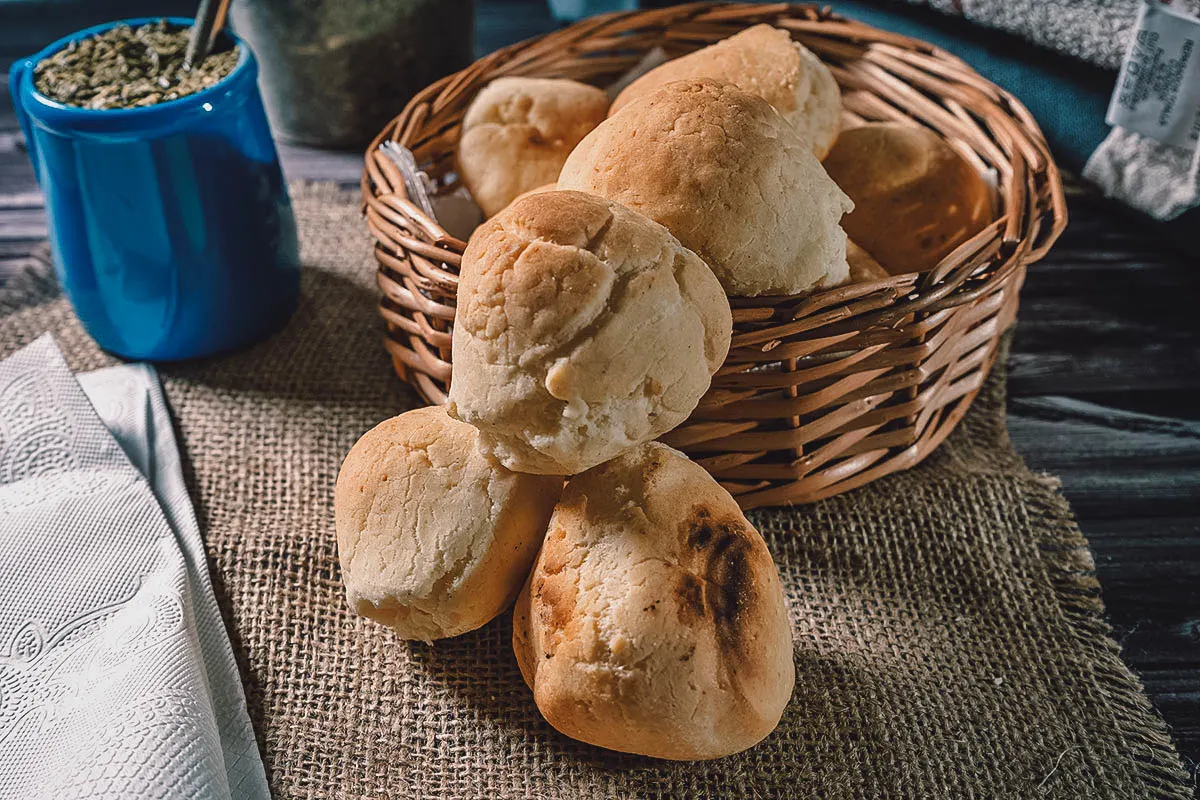
Photo by hdcaputo
12. Medialunas
Who doesn’t love croissants? These light and flaky French pastries are a favorite breakfast item on many tables around the world, including Argentina. Meaning “half moon” in Spanish, medialunas are the Argentinian version of croissants, a soft crescent roll that’s slightly smaller and a bit sweeter than the French original.
Medialunas in Argentina come in two traditional varieties – larger versions made with butter and smaller rolls made with lard. Both can be served plain or with a rum and sugar glaze on top.
Medialunas are typically eaten for breakfast or as an afternoon snack with yerba mate. They can be eaten as is or paired with sweet condiments like dulce de leche, jam, or chocolate spread.

Photo by Wirestock
MEATS / MAINS
13. Cordero Patagónico al Asador
Traveleaters with a taste for lamb will want to spend time in the provinces of Santa Cruz and Chubut in southern Argentina. Thanks to its favorable climate and abundance of natural grazing pastures, it’s home to a thriving sheep population, and subsequently, the best lamb dishes.
Cordero patagónico al asador is a Patagonian specialty of lamb roasted over an open fire. A whole lamb is butterflied and attached to a cross-shaped iron support where it’s slow-roasted next to a fire. Known as “a la cruz”, it’s a cooking method that was devised by gauchos to roast entire carcasses of meat. They’d cook the animal with its skin on (asado con cuero) to keep the meat as juicy as possible.
As the meat cooks, it’s basted with a mixture of garlic, salt, water, and various herbs and spices like rosemary, oregano, and bay leaves. The slow-roasting process results in lamb meat that’s crispy on the outside and soft and juicy on the inside. It’s delicious and an absolute must-try in Argentina.
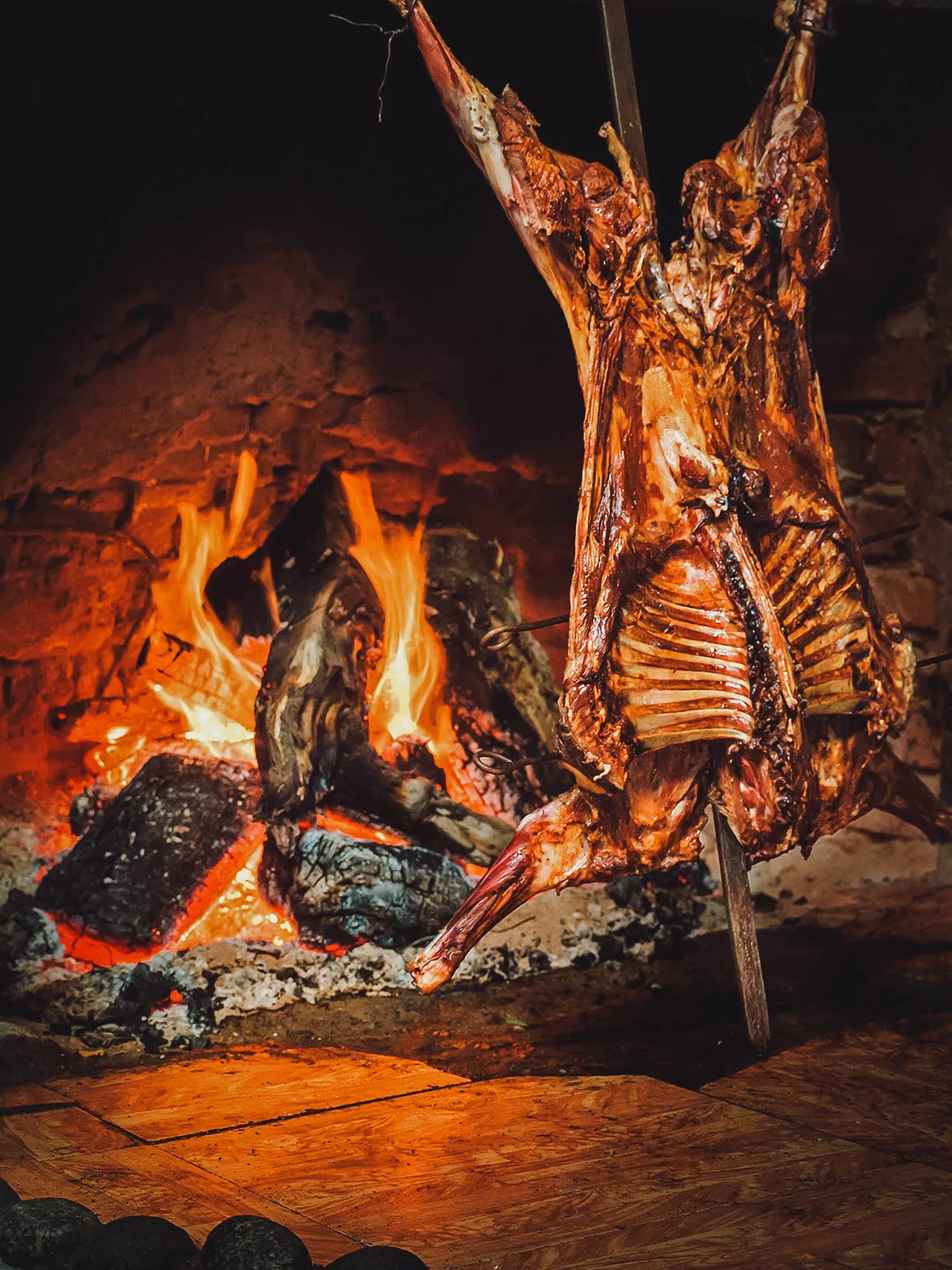
Photo by erlantzperezr.gmail.com
14. Puchero
Puchero is a Spanish stew that’s become popular in the cuisines of many countries like Argentina, Mexico, Uruguay, Paraguay, and Peru. It’s essentially the Latin American equivalent to Spanish or Portuguese cozido, but made without colorants like paprika and using whatever local ingredients were available.
In Argentina, puchero is typically made with beef and other ingredients like potatoes, corn, carrots, onions, squash, cabbage, chorizo, pork belly, and bacon. It’s a hearty and comforting stew that’s usually reserved for the colder months.
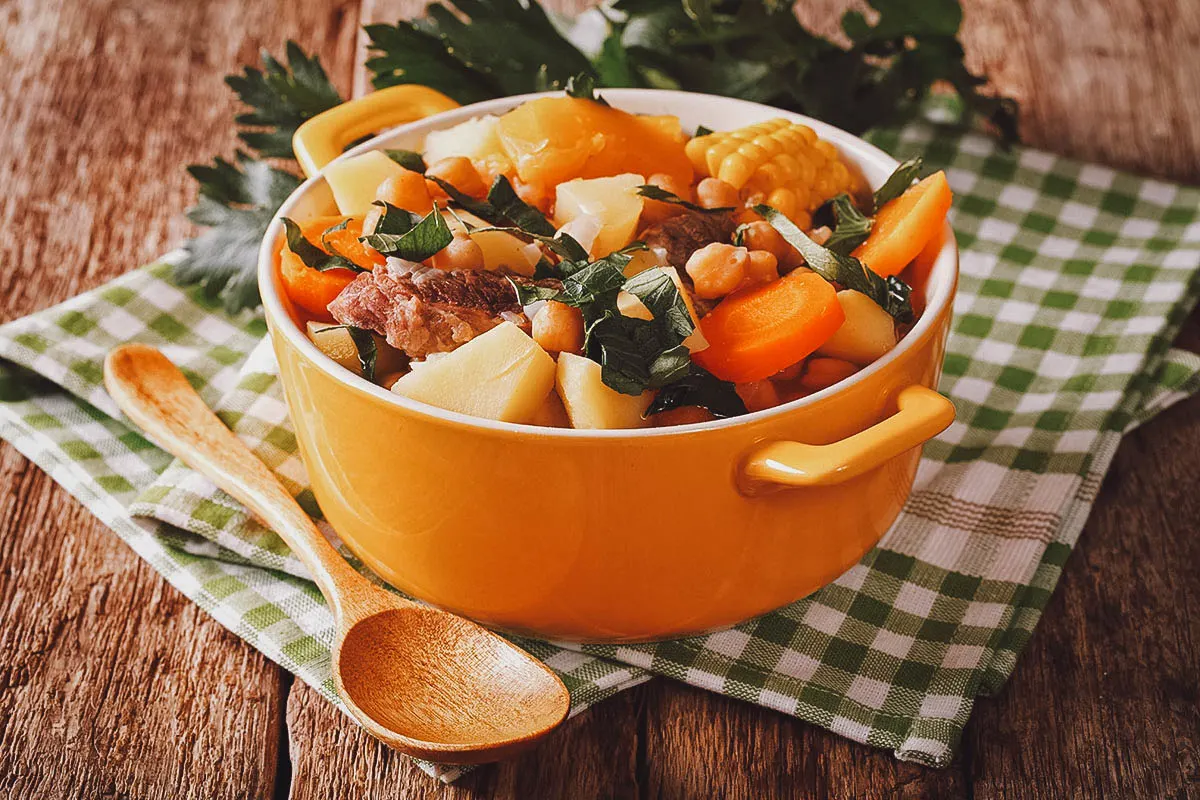
Photo by lenyvavsha
15. Fugazza
Fugazza is another Argentinian dish influenced by Italian cuisine. Similar in texture to Genovese focaccia, you can think of it as a type of Argentinian pizza made with a thick sourdough crust and without tomato sauce. It’s topped with a copious amount of caramelized onions and oregano and other ingredients like olives, artichokes, and grated parmesan cheese.
Fugazza is said to have been invented by a Genovese-Argentinian pizzaiolo named Juan Banchero sometime in the late 19th and early 20th centuries. He sold it from a pizza shop in Buenos Aires bearing his name – Banchero. It’s still open to this day.
Be sure to try fugazzetta as well, a variation of fugazza made with mozzarella sandwiched between two layers of dough.
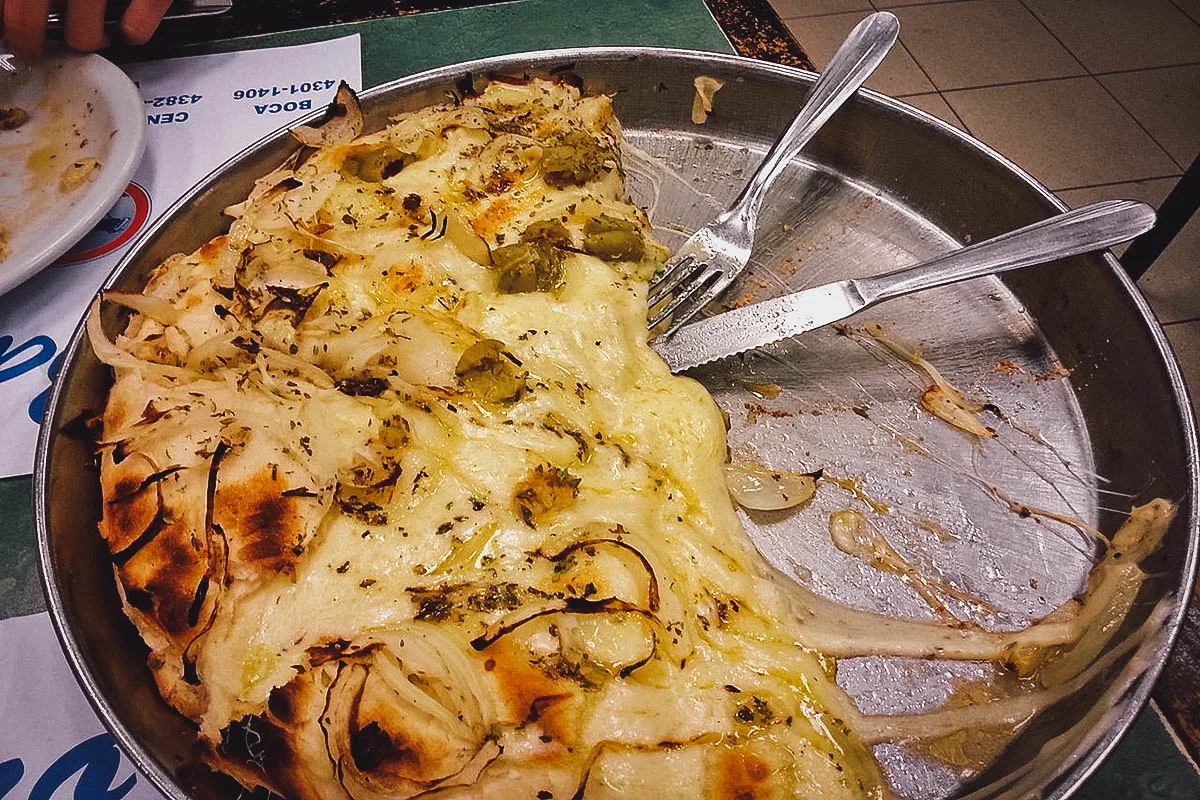
Photo by Neo139, CC0, via Wikimedia Commons
16. Ravioles
From the name alone, it’s obvious what this next dish is. Ravioles is the Argentinian version of Italian ravioli, a hugely popular pasta dish made with stuffed parcels of thin pasta dough. Like milanesa, it’s a type of quickly prepared meal in Argentina that became known collectively as minutas or “short-order dishes”.
Pictured below is a plate of ravioles smothered in chimichurri and olive oil.
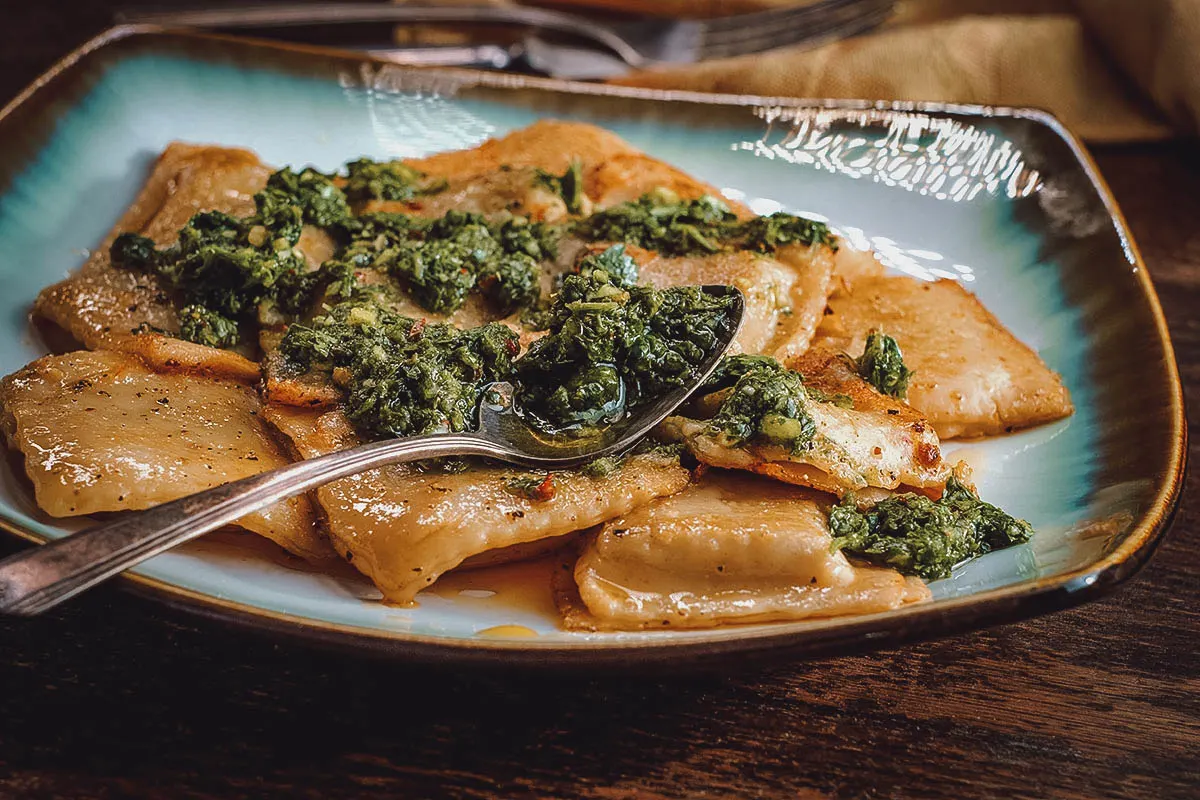
Photo by ezumeimages
17. Canelones
Like ravioles, it isn’t hard to guess what inspired this next dish. Canelones are the Argentinian equivalent of the Italian cannelloni, a cylindrical type of baked pasta dish filled with various ingredients like ricotta, spinach, and minced beef. It’s very similar to the Italian original except its made with crepes instead of pasta sheets.
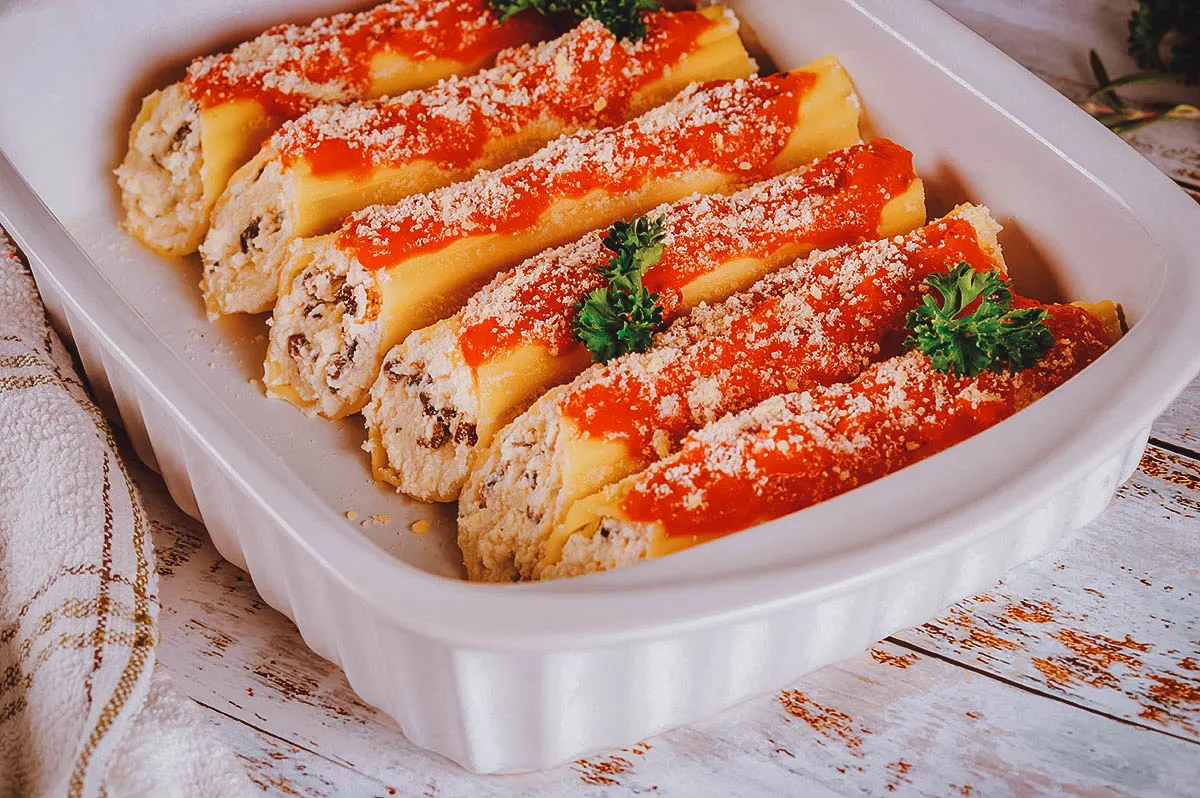
Photo by tastyfood
DESSERTS / DRINKS
18. Dulce de Leche
If you have a fondness for sweets, then you’re probably familiar with dulce de leche, the famous Argentinian confection made with caramelized milk. Popular throughout the country and in many parts of Latin America, it’s typically used as a filling or spread for pastries like alfajores and torta rogel.
Dulce de leche is made by slowly simmering sugar and milk for several hours until it thickens and turns a rich golden brown color. Milk and sugar are the basic components but other ingredients like vanilla may be added as well.
Dulce de leche is easy on the taste buds and hard not to like. Aside from being used as a filling for alfajores in Argentina, it’s also paired with many other pastries and desserts like cakes, churros, flan mixto, waffles, ice cream, and medialunas.
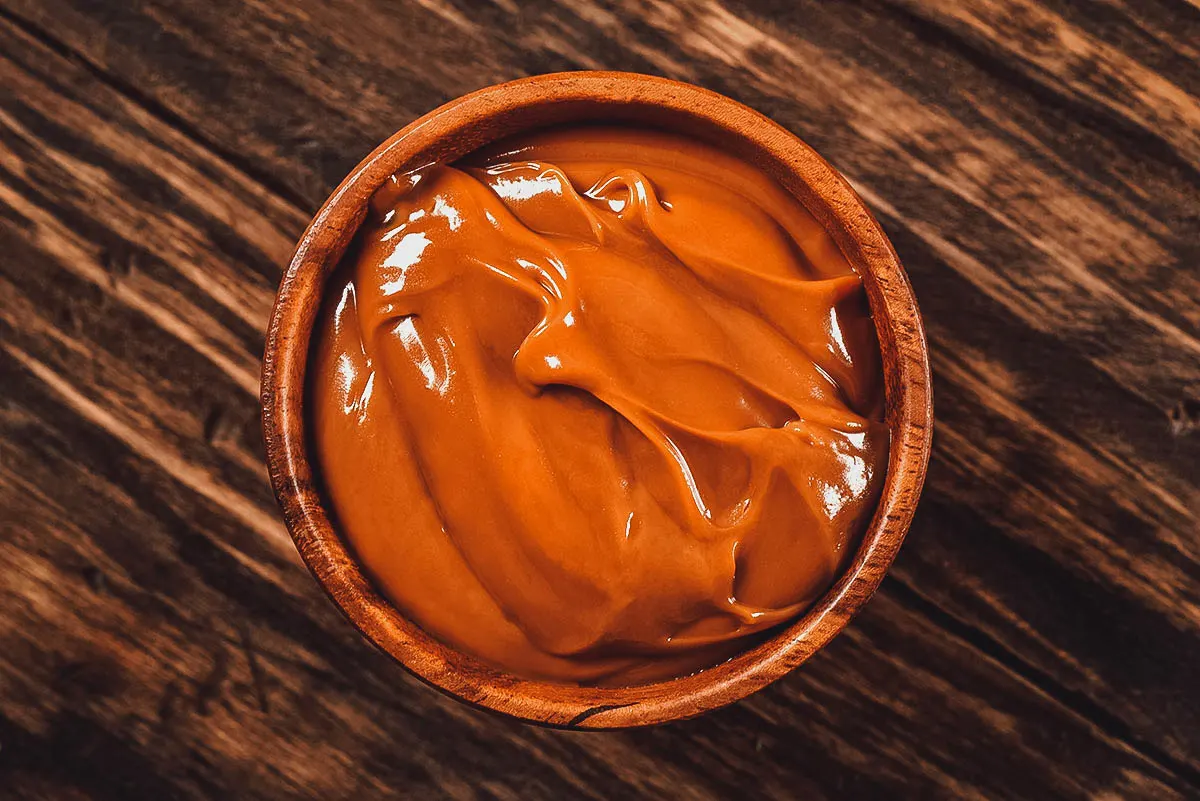
Photo by MKPK
According to legend, this delicious Argentine spread was invented by accident. In 1829, opposing civil war leaders Juan Manuel de Rosas and Juan Lavalle decided to call a truce. Rosas invited Lavalle to his ranch to discuss the terms of the pact. Tired from the journey, Lavalle laid down to rest on a cot where Rosas normally slept.
Meanwhile, one of Rosas’ servants was busy preparing lechada, a drink of hot milk and sugar that was usually taken with yerba mate. When the servant went to Rosas’ tent to serve the mate, she was startled to find Lavalle sleeping on the cot.
Unaware of the planned meeting between the two leaders, she panicked and alerted the troops to the presence of Lavalle, leaving the lechada unattended on the stove. When she came back, she found the thick and gooey spread we now know today as dulce de leche.
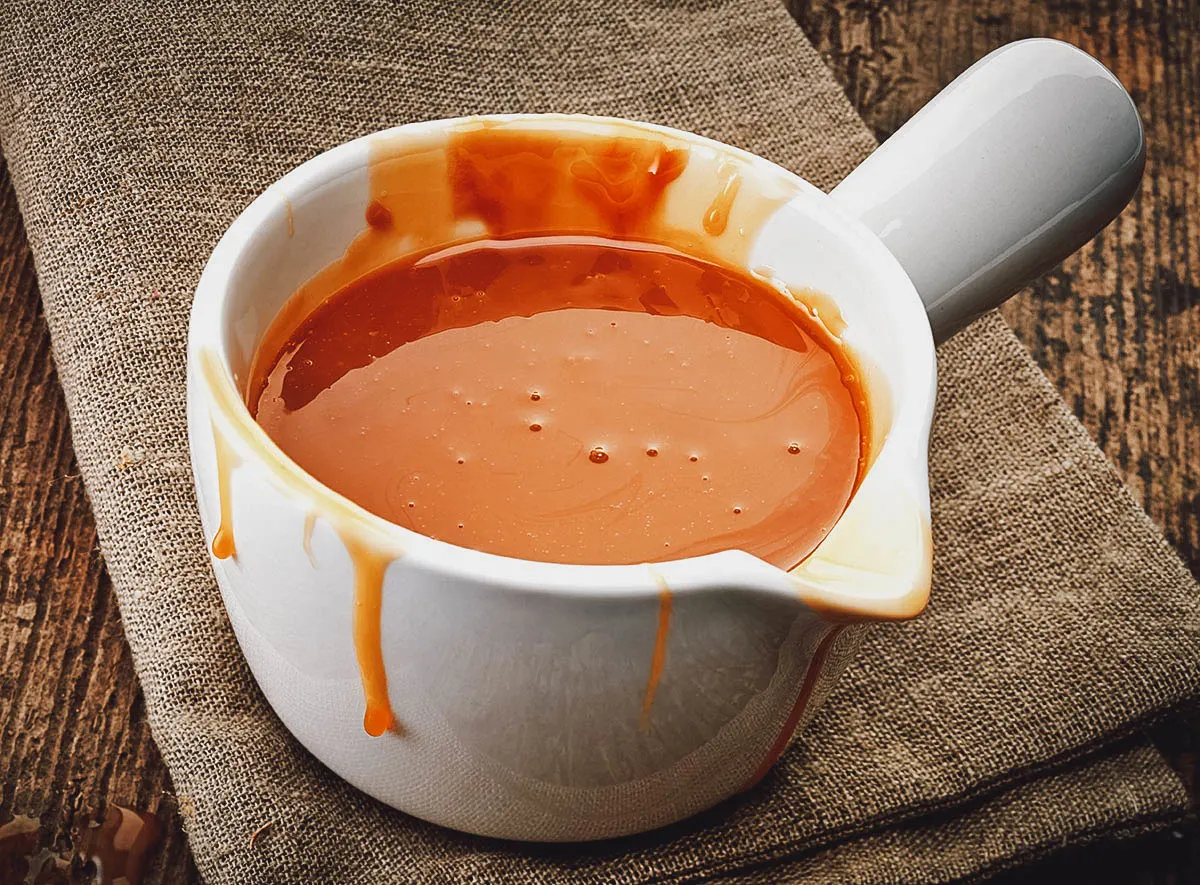
Photo by magone
19. Rogel
If you like alfajores, then you’re going to love rogel. Also known as torta rogel or alfajor rogel due to its similarity to the beloved cookies, it refers to a traditional Argentinian dessert made with thin layers of crunchy cookie biscuits held together with dulce de leche.
Similar to a mille-feuille, rogel is traditionally made with eight layers of biscuits topped with Italian meringue. What makes this dessert unique is that the cookie dough is made with egg yolks which impart a characteristic crunchiness to the biscuits.
The exact origins of the dish are unclear but one story claims that it was invented by a married couple from Buenos Aires in the 1960s. The woman’s name was Rogelia which is where the dessert got its name. Regardless of where it’s from, it’s a beloved pastry and a common sight at many Argentinian gatherings.

Photo by scottiebumich
20. Pastelitos Criollos
Pastelitos criollos are deep-fried Argentinian snacks made with puff pastry and a filling of quince (dulce de membrillo) or sweet potato paste (dulce de batata). When submerged in hot oil, the puff pastry separates into many layers which is what gives the snack its characteristic floral appearance. The pastries are fried till crispy and then brushed with a sugar glaze.
Pastelitos criollos are enjoyed year-round but like locro, they gain special significance during the May 25th anniversary of the Argentine Revolution. On May 25, 1810, women selling baskets of pastelitos circulated around the government house in Buenos Aires while people waited for an important announcement to be made. Later that day, a new local government was established, setting Argentina on the path towards independence from Spain.
From that day, pastelitos have become inextricably linked to the anniversary celebrations of the May Revolution.
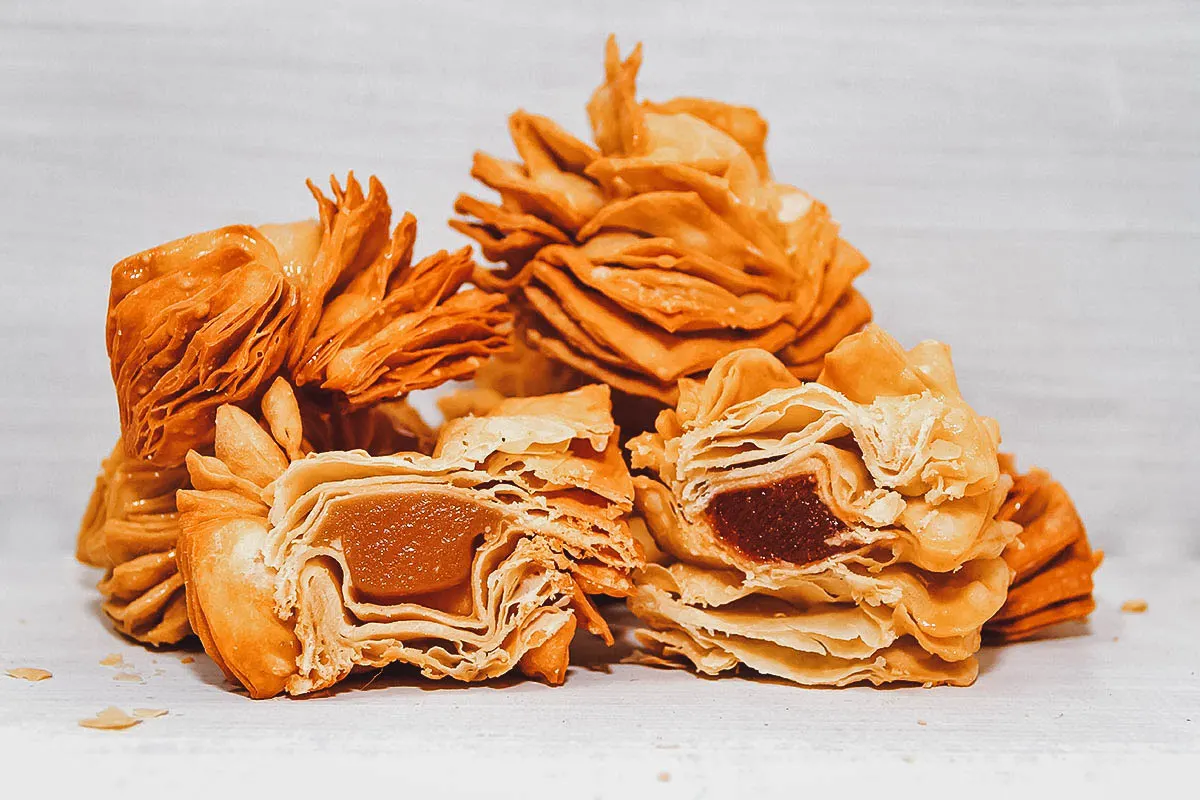
Photo by gabrielabertolini
21. Pionono
A pionono is a type of rolled cake originally from the town of Santa Fe, just west of Granada. It’s a thin, soft, and airy sponge cake made with flour, eggs, and sugar. The cake can be filled with any number of ingredients – both sweet and savory – and then rolled up into cylindrical form.
The Spanish version of pionono is a small pastry that doesn’t contain any fillings. It’s rolled up into a bite-sized cylinder before being drenched with syrup and topped with toasted cream. In Latin American countries however, piononos are larger and filled with a variety of different ingredients.
Dulce de leche, chantilly cream, and sliced fruits are common fillings for Argentine sweet piononos while savory versions are typically filled with tuna, smoked salmon, ham, turkey, cheese, hard-boiled eggs, and olives. The roll is still sweet so savory piononos have an interesting sweet/savory flavor profile Argentinians like to call agri-dulce.
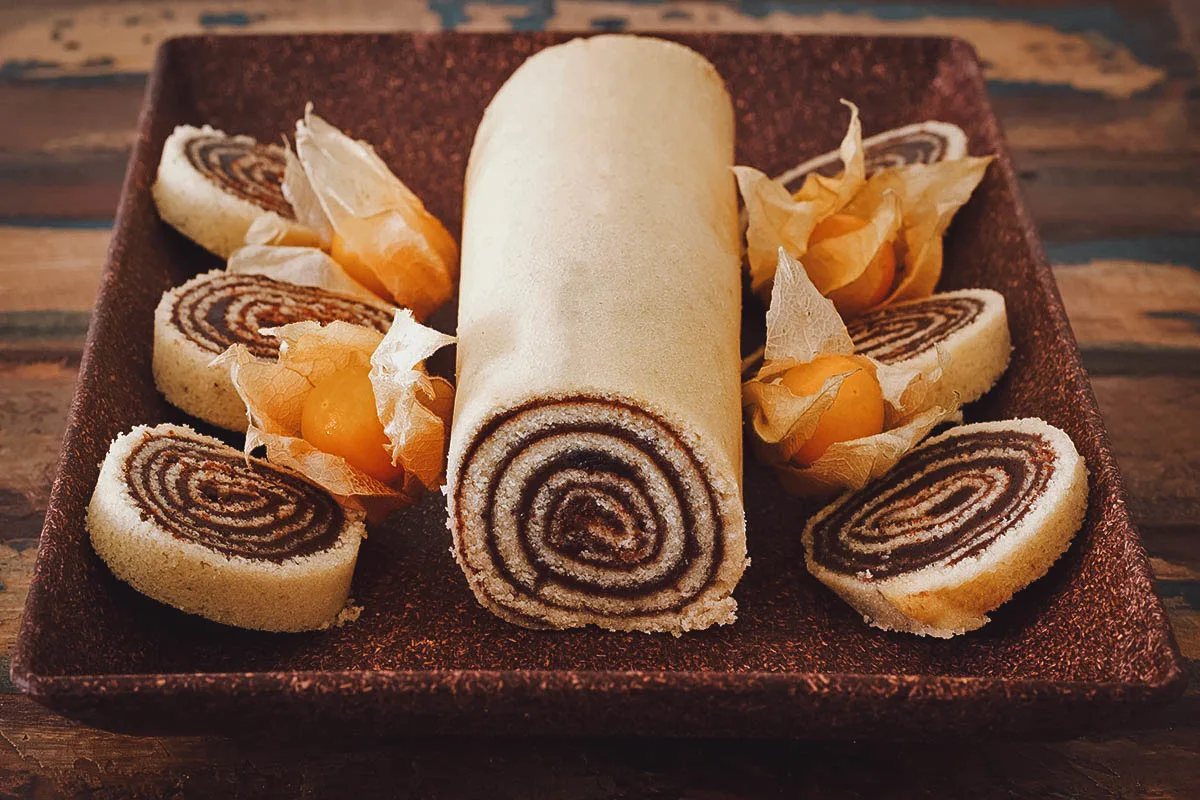
Photo by jantroyka
Pictured below is a type of savory pionono filled with a variety of different ingredients. Known locally as arrollado primavera, it’s a common sight on holiday tables in Argentina.
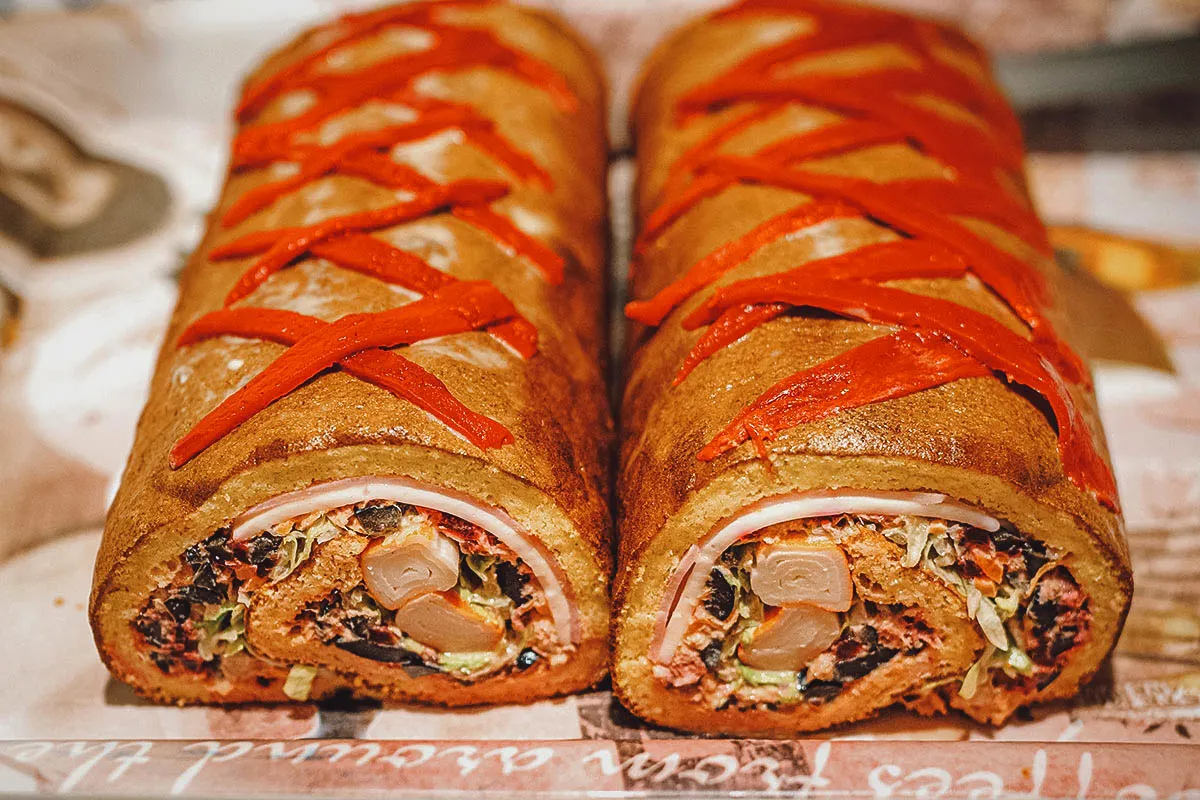
Photo by erlantzperezr.gmail.com
22. Panqueque de Dulce de Leche
This simple but comforting dessert is yet another testament to the Argentinians’ love for dulce de leche. As its name suggests, panqueue de dulce de leche is a rolled crepe pancake filled with a generous amount of that beloved caramel spread.
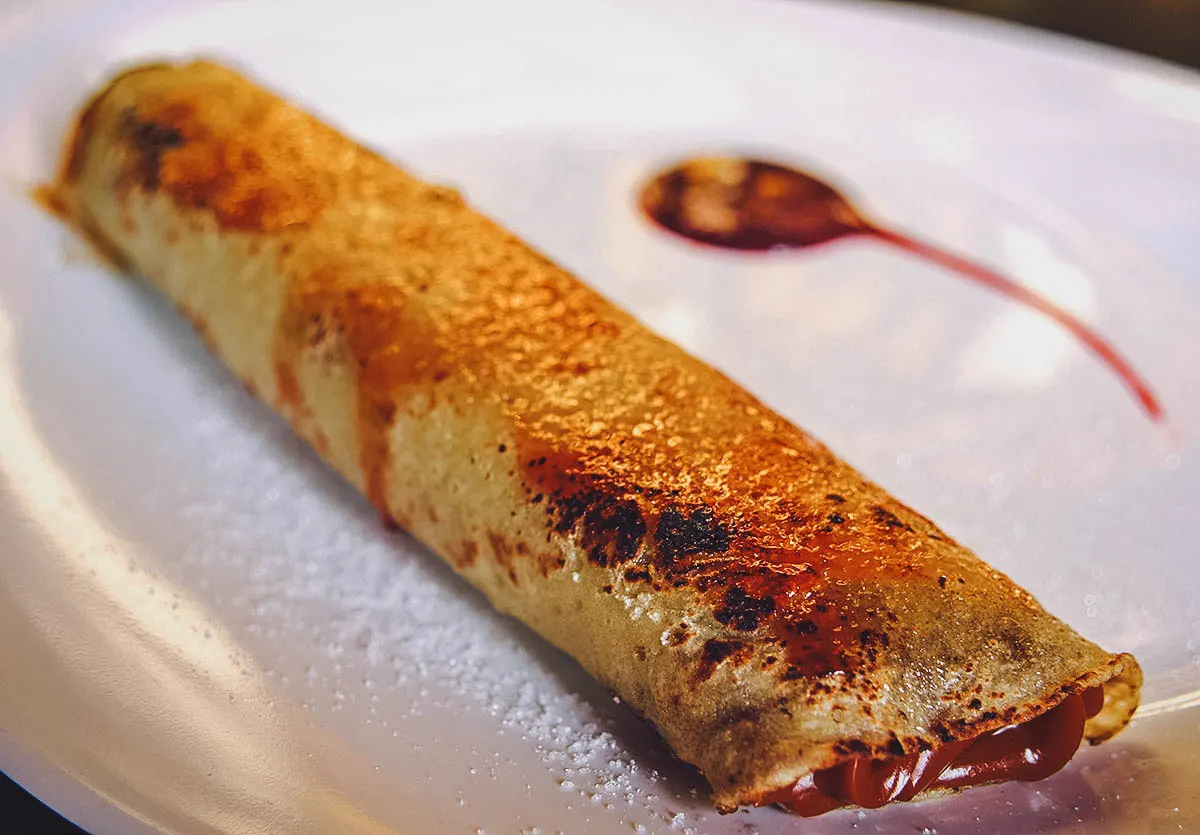
Photo by Damianchiappe
23. Flan Mixto
Flan mixto is the Argentinian version of creme caramel or custard flan. It’s a popular dessert often made at home or served at Argentinian restaurants, usually with a dollop of whipped cream and dulce de leche.
The flan is delicious enough on its own, but pairing it with dulce de leche and whipped cream is like a sweet and creamy explosion on your taste buds.
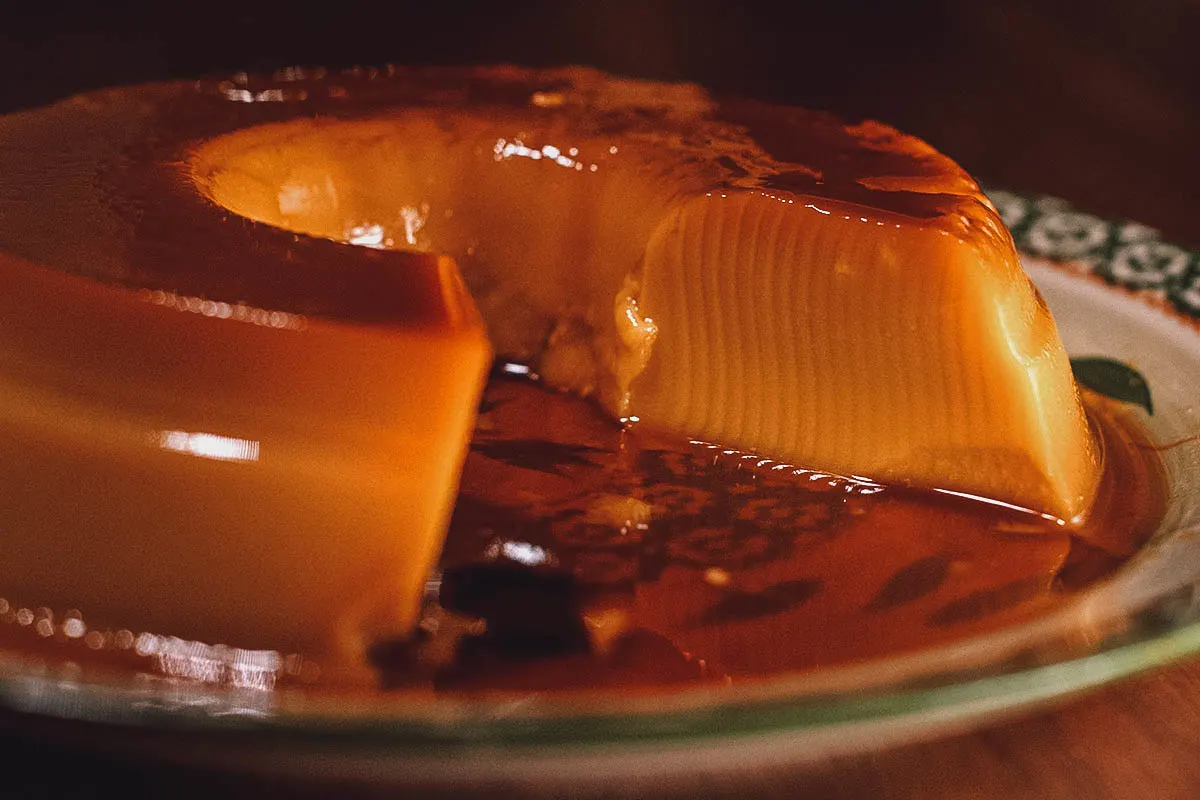
Photo by tomycoudures
24. Postre Vigilante
Postre vigilante is an easy-to-make Argentinian dessert consisting of a thick slice of cheese topped with a jelly-like fruit paste (dulce). Like pastelitos, dulce made from quince or sweet potatoes are commonly used though it can be made with other ingredients as well like elderberry, raspberry, pumpkin, and cactus.
It’s said that this dessert was invented in the 1920s by a Buenos Aires cantina frequented by police officers. “Vigilante” was a colloquial word for police officers hence the dessert’s name.
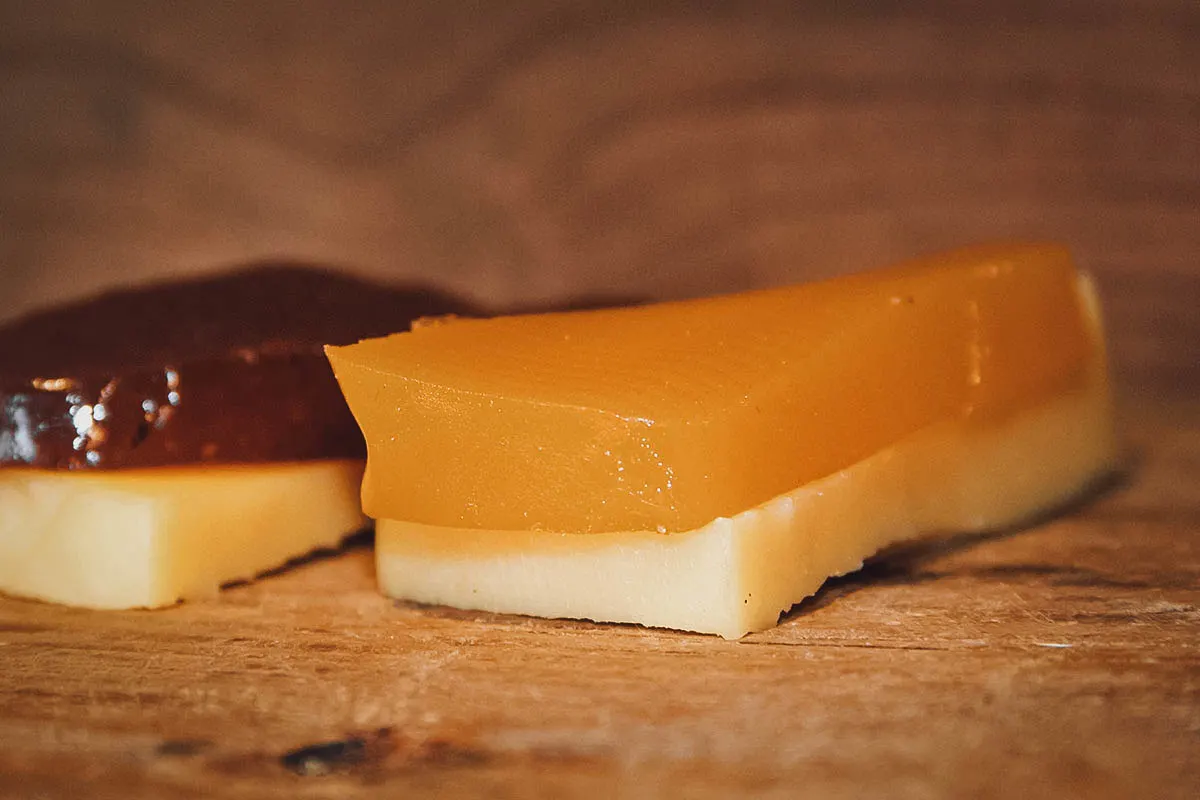
Photo by Wirestock
25. Mate
Mate is a type of herbal tea made from the leaves of the yerba mate plant. Widely consumed in Argentina, Uruguay, and Paraguay, it’s made by steeping the leaves of the plant in hot water. When prepared with cold water and ice, it’s known as tereré.
The preparation and consumption of yerba mate is steeped in ritual. It’s traditionally prepared by filling a hollowed-out gourd or container with dry yerba mate leaves and hot water. When ready, friends and family share the same container and drink from the same wooden or metal straw called a bombilla.
The brewer of the mate passes the gourd to each person, usually in a circle. The recipient gives thanks, takes a sip, and then passes the gourd back to the brewer. The brewer refills the gourd before passing it on to the next person in a clockwise order.
Infused with caffeine, yerba mate is especially popular in the mornings. It’s so popular that Argentinians will often gather to drink mate much in the same way that people meet for coffee or tea.
Pro Tip: NEVER stir the mate with the bombilla. This is considered a cultural faux pas in Argentina, one that many foreigners apparently often make.
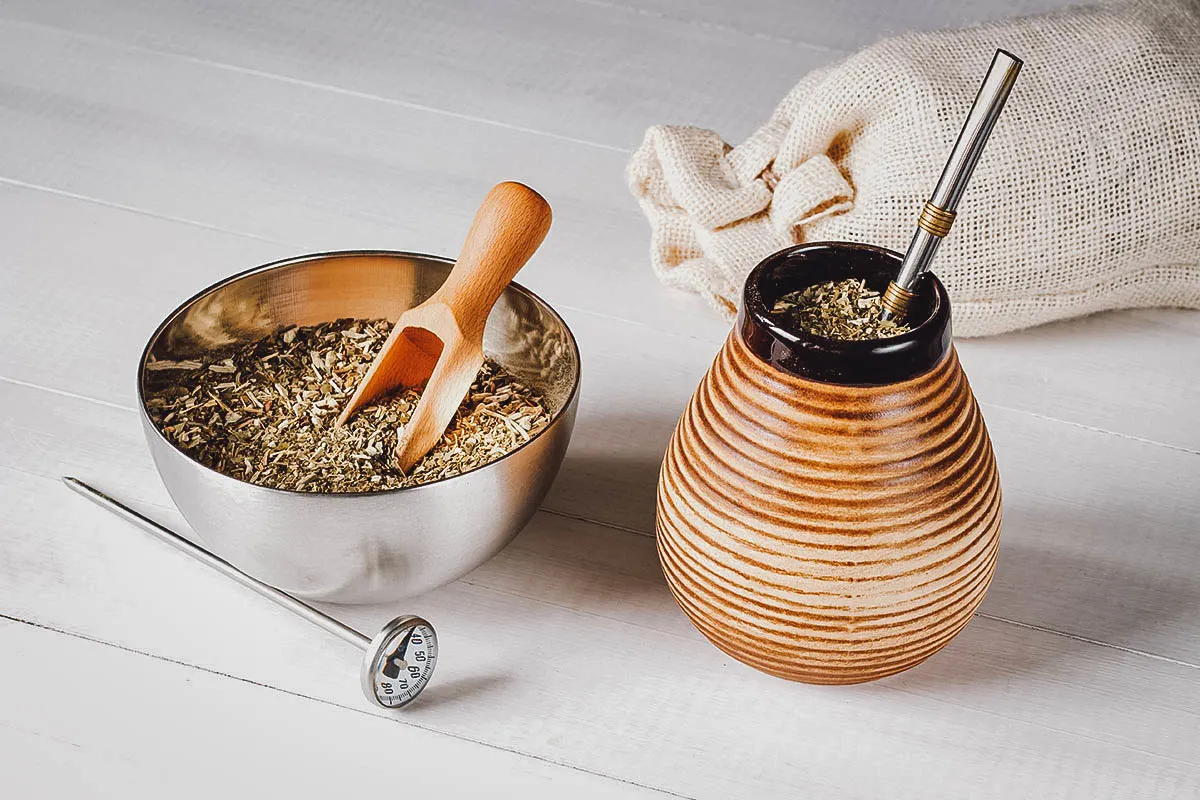
Photo by marcinm111
ARGENTINE FOOD TOURS
It’s fun exploring the local cuisine on your own, but if you’d like to really learn about the different foods in Argentina, then you may want to go on a guided tour. Simply put, no one knows Argentine food better than a local so what better way to experience the best of Argentinian cuisine than by going on a food tour?
A knowledgeable guide will take you to the city’s best restaurants, markets, and street food stalls and explain all the dishes to you in more detail. Check out Get Your Guide for a list of Argentine food tours in Buenos Aires and in other cities throughout the country.
FINAL THOUGHTS ON THE FOOD IN ARGENTINA
There are so many reasons to visit Argentina. It’s the birthplace of tango and a mecca for football. It’s produced global icons like Diego Maradona, Lionel Messi, and Eva Perón. Patagonia offers fantastic hiking opportunities while Iguazu Falls is frequently cited for being one of the world’s most beautiful waterfalls.
And as evidenced by this list, it’s not such a bad destination for food and wine lovers either. Asado may be the most famous but it’s just one part of the rich tapestry that is Argentinian cuisine.
Disclosure
Some of the links in this Argentine food guide are affiliate links. If you make a booking, then we’ll earn a small commission at no additional cost to you. As always, we only recommend products and services that we use ourselves and firmly believe in. We really appreciate your support as it helps us make more of these free travel and food guides. Gracias!
Cover photo by lenyvavsha. Stock images via Depositphotos.


Landia
Monday 22nd of August 2022
Love your website and learned do much about Argentina through your recipes but what fo vegetarians eat in Argentina
JB & Renée
Friday 26th of August 2022
Happy to hear that Landia! I'm sorry but we're not vegetarians so I'm afraid I'm not too versed with vegetarian food in Argentina.
el javi
Wednesday 23rd of March 2022
TREMENDOOOOOO
JB & Renée
Wednesday 23rd of March 2022
@el javi: ¡Muchisimas gracias!
Enrique Daniel
Sunday 30th of January 2022
Pizza (favorite in Argentina with Anchovies) and ñoccis. Pizza: I consider the really good ones (like from the restaurant, Pizzería Los Inmortales, to be superior to any pizza I've had in New York or Chicago. Thanks for mentioning fugazza and fugazzetta, but the pizza us a major part of Argentinian cuisine. Ñoccis. Really? Every 29th of each month is ñocci day, where almost every eatery will serve their version of ñoccis. Ñoccis are also a major part of argentinian cuisine...more so than raviolis. Ciao
JB & Renée
Friday 11th of February 2022
Thanks for the recommendation Enrique! We'll look into adding ñoccis on the next article update. Cheers!
Johnny
Thursday 20th of January 2022
want to travel Argentina now👍🏼
JB & Renée
Tuesday 25th of January 2022
Happy to hear that Johnny!
CARMEN BRUNO
Wednesday 5th of January 2022
very good article Good selection of dishes. You may have forgotten paella y raviolone
JB & Renée
Friday 7th of January 2022
Thanks for the suggestions Carmen! This is a perennial work-in-progress so we'll definitely be adding more dishes in future updates.